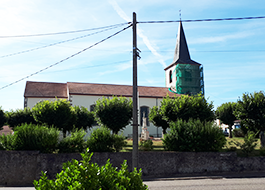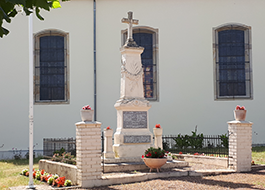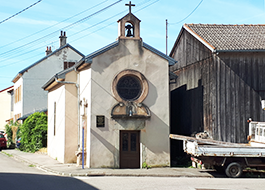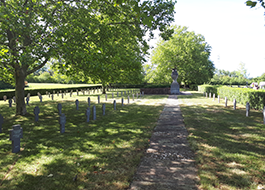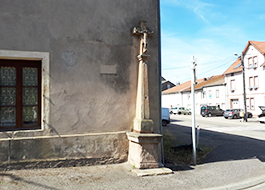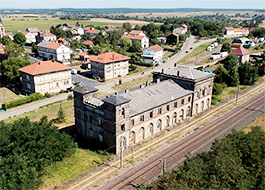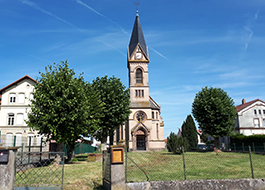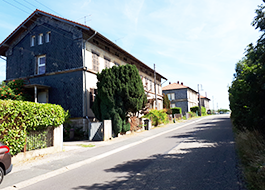Avricourt
Durée visite : 120 minutes
Moyen : Pédestre
L’ancienne commune d’Avricourt faisait partie de la Meurthe. De 1852 à 1870, la voie ferrée Paris-Strasbourg, la ligne des salines vers Dieuze, celle vers Blâmont et Cirey entraînent la construction d’une gare. En 1871, le Traité de Francfort coupe la commune en deux. Après négociations, les infrastructures ferroviaires restent à la France. Le bourg devient allemand sous le nom de Deutsch-Avricourt. Mais Paris dut financer l’édification d’une gare en territoire annexé. Celle-ci fut située à 1,3 km de la gare française. En 1919, le retour à la France maintient cette partition. Deutsch-Avricourt devenu Nouvel-Avricourt intégra la Moselle, Igney-Avricourt resta en Meurthe et Moselle.
The former commune of Avricourt was part of the Meurthe. From 1852 to 1870, the Paris-Strasbourg railway, the line of saltworks towards Dieuze, that towards Blâmont and Cirey lead to the construction of a station. In 1871, the Treaty of Frankfurt cut the town in two. After negotiations, the railway infrastructure remains in France. The village becomes German under the name of Deutsch-Avricourt. But Paris had to finance the construction of a station in annexed territory. This was located 1.3 km from the French station. In 1919, the return to France maintains this partition. Deutsch-Avricourt, which became Nouvel-Avricourt, integrated the Moselle, Igney-Avricourt remained in Meurthe et Moselle.
Die ehemalige Gemeinde Avricourt war Teil der Meurthe. Von 1852 bis 1870 führten die Eisenbahnlinie Paris-Straßburg, die Salinenlinie nach Dieuze und die Linie nach Blâmont und Cirey zum Bau eines Bahnhofs. 1871 teilte der Frankfurter Vertrag die Stadt in zwei Teile. Nach den Verhandlungen bleibt die Schieneninfrastruktur in Frankreich. Das Dorf wird unter dem Namen Deutsch-Avricourt deutsch. Aber Paris musste den Bau einer Station im annektierten Gebiet finanzieren. Dies war 1,3 km vom französischen Bahnhof entfernt. 1919 bestätigte die Rückkehr nach Frankreich diese Teilung. Deutsch-Avricourt wurde Nouvel-Avricourt integrierte die Mosel, Igney-Avricourt blieb in Meurthe et Moselle.

D’azur à trois aiglettes couronnées d’argent, au chef d’or chargé d’un sanglier de : Sable défendu d’argent.
Les aiglettes sont l’emblème de l’ancienne famille seigneuriale de Linange :le sanglier (en latin aper) rappelle le nom de la localité.
Azure, three eaglets crowned Argent, a chief Or charged with a boar of : Sable forbidden Argent.
The eaglets are the emblem of the old seigniorial family of Linange: the boar (in Latin aper) recalls the name of the locality.
Azure, three eaglets crowned Argent, a chief Or charged with a boar of : Sable forbidden Argent.
The eaglets are the emblem of the old seigniorial family of Linange: the boar (in Latin aper) recalls the name of the locality.

Les habitants et les habitantes d’Avricourt s’appellent les Avricourtois et les Avricourtoises.
The inhabitants of Avricourt are called Avricourtois and Avricourtoises.
Die Einwohner von Avricourt heißen Avricourtois und Avricourtoises.
Les points de visites
.
Elle est placée sous l’invocation de Saint Ferréol et Saint Ferjeux, martyrs apôtres de Bourgogne. De la première église construite en 1552, il ne reste que le chœur gothique voûté d’ogives, le baptistère et l’armoire eucharistique. Une partie de la tour est datée du 16e siècle. La nef, détruite pendant la guerre de Trente ans, a été reconstruite au 17e siècle puis agrandie en 1779. La nef est rattachée à la tour. La tribune est construite en 1885 sur les plans de l’architecte Leidig. La tour est alors réparée. A la suite des bombardements d’octobre et novembre 1944, le clocher, une partie des murs, de la toiture et des menuiseries sont endommagés. En 1947, l’architecte Joseph Denny supervise les travaux de reconstruction du plafond de la nef, des dallages et d’une nouvelle toiture. Le toit de la nef est couvert de tuile mécanique, le clocher d’ardoise. L’armoire eucharistique est aménagée dans le chœur. Elle est éclairée par une fenêtre trilobée. Celle-ci permettant initialement aux fidèles d’adorer le Saint-Sacrement de l’extérieur. La nef est éclairée par deux fois quatre fenêtres et le chœur par trois fenêtres. La porte d’entrée de l’église est en plein cintre avec un encadrement mouluré. De très jolis vitraux sont dus aux frères Ott de Strasbourg. L’orgue est de la Maison Dalsstein et Haerpfer. Le peintre Jaeg a restauré le Chemin de Croix en 1949. Ferréol et Ferjeux sont deux frères athéniens, martyrisés en 212 à Vesontio, aujourd’hui Besançon. Ils sont décapités sur ordre du gouverneur romain pour trouble public.
It is placed under the invocation of Saint Ferréol and Saint Ferjeux, martyr apostles of Burgundy. Of the first church built in 1552, only the Gothic rib-vaulted choir, the baptistery and the Eucharistic cupboard remain. Part of the tower is dated from the 16th century. The nave, destroyed during the Thirty Years’ War, was rebuilt in the 17th century and then extended in 1779. The nave is attached to the tower. The grandstand was built in 1885 according to the plans of the architect Leidig. The tower is then repaired. Following the bombings of October and November 1944, the bell tower, part of the walls, the roof and the joinery were damaged. In 1947, architect Joseph Denny supervised the reconstruction of the nave ceiling, paving and a new roof. The roof of the nave is covered with mechanical tiles, the steeple with slate. The Eucharistic cupboard is fitted out in the choir. It is lit by a three-lobed window. This initially allows the faithful to worship the Blessed Sacrament from the outside. The nave is lit by two times four windows and the choir by three windows. The entrance door to the church is semicircular with a molded frame. Very pretty stained glass windows are by the Ott brothers from Strasbourg. The organ is from the Dalsstein and Haerpfer House. The painter Jaeg restored the Stations of the Cross in 1949. Ferréol and Ferjeux are two Athenian brothers, martyred in 212 in Vesontio, today Besançon. They are beheaded by order of the Roman governor for public disturbance.
Es steht unter der Anrufung von Saint Ferréol und Saint Ferjeux, den Märtyreraposteln von Burgund. Von der ersten 1552 erbauten Kirche sind nur noch der gotische Rippengewölbechor, das Baptisterium und der eucharistische Schrank erhalten. Ein Teil des Turms stammt aus dem 16. Jahrhundert. Das während des Dreißigjährigen Krieges zerstörte Kirchenschiff wurde im 17. Jahrhundert wieder aufgebaut und 1779 erweitert. Das Kirchenschiff ist an den Turm angeschlossen. Die Tribüne wurde 1885 nach den Plänen des Architekten Leidig erbaut. Der Turm wird dann repariert. Nach den Bombenanschlägen vom Oktober und November 1944 wurden der Glockenturm, ein Teil der Mauern, das Dach und die Tischlerei beschädigt. 1947 überwachte der Architekt Joseph Denny den Wiederaufbau der Decke des Kirchenschiffs, der Pflasterung und eines neuen Daches. Das Dach des Kirchenschiffs ist mit mechanischen Ziegeln bedeckt, der Kirchturm mit Schiefer. Der eucharistische Schrank ist im Chor eingerichtet. Es wird von einem dreilappigen Fenster beleuchtet. Dies ermöglicht es den Gläubigen zunächst, das Allerheiligste Sakrament von außen anzubeten. Das Kirchenschiff wird durch zwei mal vier Fenster und der Chor durch drei Fenster beleuchtet. Die Eingangstür zur Kirche ist halbkreisförmig mit einem geformten Rahmen. Sehr hübsche Buntglasfenster stammen von den Brüdern Ott aus Straßburg. Die Orgel stammt aus dem Dalsstein- und Haerpferhaus. Der Maler Jaeg restaurierte 1949 die Kreuzwegstationen. Ferréol und Ferjeux sind zwei athenische Brüder, die 212 in Vesontio, heute Besançon, den Märtyrertod erlitten haben. Sie werden auf Befehl des römischen Gouverneurs wegen öffentlicher Unruhen enthauptet.
.
.
Cette colonne surmontée d’une croix latine est en marbre et calcaire. Elle est dédiée aux morts des deux guerres mondiales et du conflit indochinois. Les parcours de ces hommes reflètent l’histoire tourmentée de la région. Ainsi Joseph Walter est mort sous l’uniforme allemand en Russie en 1914. Son parent Georges est mort pour la France la même année. Rodolphe Enger, Arthur Muller ou Louis Recht sont des Malgré-nous de la seconde annexion. Ils ont disparu sur le front de l’Est. Gilbert Juchs, expulsé et résistant, est exécuté dans le Gard en 1944. Son père Edmond était tombé pour la France, en Belgique en août 14.
This column surmounted by a Latin cross is in marble and limestone. It is dedicated to the dead of the two world wars and the Indochinese conflict. The journeys of these men reflect the tormented history of the region. Thus Joseph Walter died in German uniform in Russia in 1914. His relative Georges died for France the same year. Rodolphe Enger, Arthur Muller or Louis Recht are the Despite-us of the second annexation. They disappeared on the Eastern Front. Gilbert Juchs, expelled and resistant, is executed in the Gard in 1944. His father Edmond had fallen for France, in Belgium in August 14.
Diese Säule, die von einem lateinischen Kreuz überragt wird, besteht aus Marmor und Kalkstein. Es ist den Toten der beiden Weltkriege und des indochinesischen Konflikts gewidmet. Die Reisen dieser Männer spiegeln die gequälte Geschichte der Region wider. So starb Joseph Walter 1914 in deutscher Uniform in Russland. Sein Verwandter Georges starb im selben Jahr für Frankreich. Rodolphe Enger, Arthur Muller oder Louis Recht sind die Trotz-uns der zweiten Annexion. Sie verschwanden an der Ostfront. Gilbert Juchs, vertrieben und widerstandsfähig, wird 1944 im Gard hingerichtet. Sein Vater Edmond hatte sich am 14. August in Belgien in Frankreich verliebt.
.
.
On peut voir sur sa façade le blason du village. Les aiglettes appartenaient aux seigneurs de Linange, le sanglier, aper en latin, fait allusion à l’étymologie possible d’Avricourt. Les Linange sont une famille princière allemande. Elle remonte au XIIe siècle. Ils possédèrent le comté de Dabo et la seigneurie de Réchicourt. Ils furent chassés par la Révolution française. La veuve du prince Charles de Linange épousa Edouard, duc de Kent. Ils donnèrent naissance à la future reine Victoria d’Angleterre. La commune ne comptait que 956 habitants au moment le l’annexion de 1871. L’essor économique, dû notamment au chemin de fer, fit monter ce chiffre à 1267 en 1880. En 2017, il est de 612 personnes.
We can see on its facade the coat of arms of the village. The eaglets belonged to the lords of Linange, the wild boar, aper in Latin, alludes to the possible etymology of Avricourt. The Linanges are a German princely family. It dates back to the 12th century. They owned the county of Dabo and the seigneury of Réchicourt. They were driven out by the French Revolution. The widow of Prince Charles of Linange married Edward, Duke of Kent. They gave birth to the future Queen Victoria of England. The town had only 956 inhabitants at the time of the annexation of 1871. The economic boom, due in particular to the railroad, raised this figure to 1267 in 1880. In 2017, it was 612 people.
Wir können an seiner Fassade das Wappen des Dorfes sehen. Die Adler gehörten den Herren von Linange, der lateinische Wildschwein spielt auf die mögliche Etymologie von Avricourt an. Die Linanges sind eine deutsche Fürstenfamilie. Es stammt aus dem 12. Jahrhundert. Sie besaßen die Grafschaft Dabo und das Seigneury von Réchicourt. Sie wurden von der Französischen Revolution vertrieben. Die Witwe von Prinz Charles von Linange heiratete Edward, Herzog von Kent. Sie gebar die zukünftige Königin Victoria von England. Die Stadt hatte zum Zeitpunkt der Annexion von 1871 nur 956 Einwohner. Der wirtschaftliche Aufschwung, insbesondere aufgrund der Eisenbahn, erhöhte diese Zahl 1880 auf 1267. 2017 waren es 612 Einwohner.
.
.
Elle est construite à la suite du vœu d’un marchand du village. Celui-ci, Joseph Deviot, fut agressé chez lui vers 1725. Il s’en remit à Notre Dame des Ermites, objet d’un célèbre pèlerinage en Suisse. Sauvé, il édifia cette chapelle. La Vierge noire, portant l’enfant sur son bras, et habillée de l’ample manteau brodé est la copie le la statue helvète. On prit l’habitude de s’y rendre en procession, aux Rogations et à l’Assomption, et la Messe y fut célébrée pour des intentions particulières. Le mobilier est aussi composé de statues de Saint Nicolas et de Saint Joseph. Les statues reposent sur des consoles en plâtre, sous des dais en bois à l’architecture néo-gothique.
It was built following the wish of a village merchant. This one, Joseph Deviot, was attacked at his home around 1725. He relied on Notre Dame des Hermites, the object of a famous pilgrimage to Switzerland. Saved, he built this chapel. The Black Madonna, carrying the child on her arm, and dressed in the ample embroidered cloak, is the copy of the Helvetian statue. We got into the habit of going there in procession, at the Rogations and at the Assumption, and Mass was celebrated there for special purposes. The furniture is also composed of statues of Saint Nicolas and Saint Joseph. The statues rest on plaster consoles, under wooden canopies with neo-Gothic architecture.
Es wurde auf Wunsch eines Dorfhändlers gebaut. Dieser, Joseph Deviot, wurde um 1725 in seinem Haus angegriffen. Er stützte sich auf Notre Dame des Hermites, das Objekt einer berühmten Pilgerreise in die Schweiz. Gerettet baute er diese Kapelle. Die Schwarze Madonna, die das Kind auf dem Arm trägt und den reichlich bestickten Umhang trägt, ist die Kopie der helvetischen Statue. Wir gewöhnten uns an, in Prozession, bei den Rogationen und bei der Himmelfahrt dorthin zu gehen, und die Messe wurde dort zu besonderen Zwecken gefeiert. Die Möbel bestehen auch aus Statuen des Heiligen Nikolaus und des Heiligen Josef. Die Statuen ruhen auf Gipskonsolen unter hölzernen Vordächern mit neugotischer Architektur.
.
.
Le cimetière militaire allemand regroupe 177 tombes. La majorité abritent des soldats du Kaiser. A noter la présence de soldats russes, combattant aux côtés de la France. Ils appartenaient au corps expéditionnaire envoyé par le tsar. En 1917, les survivants furent retirés du front après les troubles révolutionnaires de Russie. On craignait une contagion pacifiste, voire carrément bolchévique. Des soldats français reposent aussi ici. On trouve également le monument dédié à Nissim de Camondo. Ce dernier est un aviateur tué en septembre 1917, Vétéran de Verdun et de la Somme, il est observateur-photographe. Il est abattu au-dessus de Leintrey avec son co-pilote. Il avait 25 ans. Son père, le banquier et collectionneur Moïse de Camondo, reçoit les condoléances de son ami Marcel Proust. Il fait de son hôtel particulier un musée d’Arts Décoratifs, dédié à son fils, rue Monceau à Paris. Une stèle semblable existe à Leintrey. Mais la dépouille de Nissim a été rapatriée d’Avricourt, par son père, au cimetière de Montmartre.
The German military cemetery contains 177 graves. The majority are home to the Kaiser’s soldiers. Note the presence of Russian soldiers, fighting alongside France. They belonged to the expeditionary force sent by the Tsar. In 1917 the survivors were withdrawn from the front after the revolutionary unrest in Russia. We feared a pacifist, even outright Bolshevik contagion. French soldiers are also resting here. There is also the monument dedicated to Nissim de Camondo. The latter is an aviator killed in September 1917, Veteran of Verdun and the Somme, he is an observer-photographer. He was shot down over Leintrey with his co-pilot. He was 25 years old. His father, the banker and collector Moïse de Camondo, receives condolences from his friend Marcel Proust. He turned his mansion into a Decorative Arts museum, dedicated to his son, rue Monceau in Paris. A similar stele exists at Leintrey. But Nissim’s remains were repatriated from Avricourt by his father to the Montmartre cemetery.
Der deutsche Militärfriedhof enthält 177 Gräber. Die Mehrheit beherbergt die Soldaten des Kaisers. Beachten Sie die Anwesenheit russischer Soldaten, die neben Frankreich kämpfen. Sie gehörten der vom Zaren entsandten Expeditionstruppe an. 1917 wurden die Überlebenden nach den revolutionären Unruhen in Russland von der Front zurückgezogen. Wir befürchteten eine pazifistische, sogar geradezu bolschewistische Ansteckung. Hier ruhen auch französische Soldaten. Es gibt auch das Denkmal für Nissim de Camondo. Letzterer ist ein im September 1917 getöteter Flieger, Veteran von Verdun und der Somme, er ist Beobachter-Fotograf. Er wurde mit seinem Co-Piloten über Leintrey abgeschossen. Er war 25 Jahre alt. Sein Vater, der Bankier und Sammler Moïse de Camondo, erhält von seinem Freund Marcel Proust sein Beileid. Er verwandelte sein Herrenhaus in ein Museum für dekorative Kunst, das seinem Sohn, der Rue Monceau in Paris, gewidmet war. Eine ähnliche Stele gibt es in Leintrey. Aber Nissims Überreste wurden von seinem Vater von Avricourt auf den Friedhof von Montmartre zurückgeführt.
.
.
Située au coin des rues des Halles et de Lorraine, cette croix a été érigée par Joseph Deviot. C’était un commerçant aisé d’Avricourt. Il fut attaqué dans son lit par des voisins jaloux. Il échappa à leur étranglement. Il fit édifier en reconnaissance la chapelle Notre-Dame-des-Ermites. En attendant la fin des travaux, retardés par des recours de villageois, il fit poser cette croix, sorte d’acompte sur la dette qu’il devait à Ses Protecteurs.
Located at the corner of rue des Halles and rue de Lorraine, this cross was erected by Joseph Deviot. He was a wealthy trader from Avricourt. He was attacked in his bed by jealous neighbors. He escaped their strangulation. He had the Notre-Dame-des-Ermites chapel built in recognition. While waiting for the end of the work, delayed by appeals from the villagers, he had this cross placed, a sort of down payment on the debt he owed to his Protectors.
Dieses Kreuz befindet sich an der Ecke Rue des Halles und Rue de Lorraine und wurde von Joseph Deviot errichtet. Er war ein reicher Händler aus Avricourt. Er wurde in seinem Bett von eifersüchtigen Nachbarn angegriffen. Er entkam ihrer Würgung. Er ließ die Kapelle Notre-Dame-des-Ermites anerkennen. Während er auf das Ende der Arbeit wartete, verzögert durch Appelle der Dorfbewohner, ließ er dieses Kreuz platzieren, eine Art Anzahlung auf die Schulden, die er seinen Beschützern schuldete.
.
.
Construite en 1890 pendant la première annexion, cette maison est nommée Villa Hann. Elle est de style néo-gothique, comme plusieurs villas contemporaines édifiées par de riches commerçants. Elle était la propriété d’un négociant en poisson. La pisciculture est importante grâce aux nombreux étangs. Aujourd’hui elle est habitée par plusieurs locataires. Construite en pierre de taille de grès, elle est de plan rectangulaire. Les porches sont à deux niveaux, celui de gauche porte une logette vitrée, couverte d’un toit à trois pans, le second porte un balcon en pierre pleine avec quadrilobe gravé. Le porche de gauche est composé des quatre colonnes en fonte à chaque niveau. Celui de droite de deux qui supportent le balcon. La maison est à deux étages carrés. Un escalier tournant en pierre mène à l’étage. Il est doté d’une rampe en fonte de fer ajourée. Les baies du rez-de-chaussée sont rectangulaires et en grès rose, celles de l’étage sont en arc segmentaire et en grès gris, le même contraste entre les deux niveaux existe avec une pierre de taille grise au rez-de-chaussée et rose à l’étage. Le toit supporte une logette avec une baie à deux meneaux couverte en pavillon. Le toit est couvert d’ardoises. Une corniche à denticule orne tout le tout de la maison.
Built in 1890 during the first annexation, this house is called Villa Hann. It is neo-Gothic in style, like several contemporary villas built by wealthy traders. It was owned by a fish trader. Fish farming is important thanks to the many ponds. Today it is inhabited by several tenants. Built in cut sandstone, it has a rectangular plan. The porches are on two levels, the one on the left has a glazed cubicle, covered with a three-sided roof, the second has a solid stone balcony with carved quatrefoil. The left porch is made up of four cast iron columns on each level. The one on the right of two which support the balcony. The house is two square storeys. A winding stone staircase leads upstairs. It has an openwork cast iron ramp. The bays on the ground floor are rectangular and in pink sandstone, those on the first floor are in segmental arch and in gray sandstone, the same contrast between the two levels exists with a gray ashlar on the ground floor and pink upstairs. The roof supports a cubicle with a bay with two mullions covered as a pavilion. The roof is covered with slates. A dentil cornice adorns the whole of the house.
Dieses Haus wurde 1890 während der ersten Annexion erbaut und heißt Villa Hann. Es ist neugotisch im Stil, wie mehrere zeitgenössische Villen, die von wohlhabenden Händlern erbaut wurden. Es war im Besitz eines Fischhändlers. Die Fischzucht ist dank der vielen Teiche wichtig. Heute wird es von mehreren Mietern bewohnt. Erbaut aus geschnittenem Sandstein, hat es einen rechteckigen Grundriss. Die Veranden befinden sich auf zwei Ebenen, die eine auf der linken Seite hat eine verglaste Kabine, die mit einem dreiseitigen Dach bedeckt ist, die zweite hat einen Balkon aus massivem Stein mit geschnitztem Vierpass. Die linke Veranda besteht aus vier Gusseisensäulen auf jeder Ebene. Die rechts von zwei, die den Balkon tragen. Das Haus hat zwei quadratische Stockwerke. Eine gewundene Steintreppe führt nach oben. Es hat eine durchbrochene Rampe aus Gusseisen. Die Buchten im Erdgeschoss sind rechteckig und aus rosa Sandstein, die im ersten Stock sind aus Segmentbogen und aus grauem Sandstein, der gleiche Kontrast zwischen den beiden Ebenen besteht mit einem grauen Quader im Erdgeschoss und rosa im Obergeschoss. Das Dach trägt eine Kabine mit einer Bucht mit zwei als Pavillon bedeckten Pfosten. Das Dach ist mit Schiefer gedeckt. Ein Dentilgesims schmückt das ganze Haus.
.
.
Elle fut édifiée en 1875 par des fonds français, en échange des voies ferrées et de la gare d’Avricourt, laissées à la France. Elle fut baptisée Deutsch-Avricourt. Le bâtiment est de style monumental néo-roman. L’architecte Jacobststhal voulait affirmer le prestige du Reich Wilhemien. 57 fenêtres,10 portes, 4 tours d’angle, une poste, une halle à marchandises et une rotonde équipent cette gare de 100m de long sur 18 de large. Une partie a disparu sous les bombes en 14-18. Les tracas ne furent pas épargnés aux voyageurs français. Sauf pour l’Orient-Express créé en 1883, les trains français en provenance de Lunéville et Nancy avaient pour terminus la gare de Deutsch-Avricourt. Tous les panneaux étaient écrits en allemand, en écriture gothique et aucun en français. Les passagers étaient débarqués. Le train français repartait aussitôt à vide stationner en gare d’Igney-Avricourt. Après avoir passé les contrôles allemands de police et de douanes particulièrement longs, les passagers attendaient l’arrivée du train allemand de la compagnie Elsass-Lothringen. Ce dernier partait en circulation à droite, avec signalisation allemande pour Sarrebourg et Strasbourg. Alors que les trains français circulaient à gauche. Un détail supplémentaire fut ajouté par les Allemands. Pour bien marquer l’entrée dans l’Empire, les voyageurs devaient avancer leur montre de 55 minutes, et non pas une heure pleine, en arrivant en Alsace-Lorraine. Les guides touristiques Baedeker précisaient toutes ces formalités à leurs clients. La gare a été fermée en 1969. Des projets de restauration sont en cours.
It was built in 1875 by French funds, in exchange for the railways and the Avricourt station, left to France. It was baptized Deutsch-Avricourt. The building is in a neo-Romanesque monumental style. The architect Jacobststhal wanted to assert the prestige of the Wilhemien Reich. 57 windows, 10 doors, 4 corner towers, a post office, a goods hall and a rotunda equip this 100m long by 18 wide station. A part disappeared under the bombs in 14-18. The hassles were not spared to French travelers. Except for the Orient-Express created in 1883, French trains from Lunéville and Nancy terminated at Deutsch-Avricourt station. All the signs were written in German, in Gothic script and none in French. The passengers were disembarked. The French train immediately left empty and parked at the Igney-Avricourt station. After having passed the particularly long German police and customs checks, the passengers awaited the arrival of the German train of the company Elsass-Lothringen. The latter left in traffic on the right, with German signs for Sarrebourg and Strasbourg. While French trains were traveling on the left. An additional detail was added by the Germans. To mark the entry into the Empire, travelers had to advance their watch by 55 minutes, and not a full hour, when arriving in Alsace-Lorraine. The Baedeker tourist guides explained all these formalities to their clients. The station was closed in 1969. Restoration projects are underway.
Es wurde 1875 von französischen Geldern im Austausch für die Eisenbahnen und den Avricourt-Bahnhof gebaut und nach Frankreich verlassen. Es wurde Deutsch-Avricourt getauft. Das Gebäude ist im neoromanischen Monumentalstil gehalten. Der Architekt Jacobststhal wollte das Prestige des Wilhemischen Reiches behaupten. 57 Fenster, 10 Türen, 4 Ecktürme, ein Postamt, eine Warenhalle und eine Rotunde rüsten diese 100 m lange und 18 m breite Station aus. Ein Teil verschwand zwischen 14 und 18 unter den Bomben. Die Probleme wurden französischen Reisenden nicht erspart. Mit Ausnahme des 1883 geschaffenen Orient-Express endeten französische Züge von Lunéville und Nancy am Bahnhof Deutsch-Avricourt. Alle Zeichen wurden in deutscher, gotischer und keine in französischer Schrift geschrieben. Die Passagiere wurden von Bord gebracht. Der französische Zug fuhr sofort leer und parkte am Bahnhof Igney-Avricourt. Nachdem die Passagiere die besonders langen deutschen Polizei- und Zollkontrollen bestanden hatten, warteten sie auf die Ankunft des deutschen Zuges der Firma Elsass-Lothringen. Letzterer links im Verkehr rechts, mit deutschen Schildern nach Sarrebourg und Straßburg. Während französische Züge auf der linken Seite fuhren. Ein zusätzliches Detail wurde von den Deutschen hinzugefügt. Um den Eintritt in das Imperium zu markieren, mussten Reisende ihre Uhr bei ihrer Ankunft in Elsass-Lothringen um 55 Minuten und nicht um eine volle Stunde vorrücken. Die Baedeker-Reiseführer erklärten ihren Kunden all diese Formalitäten. Die Station wurde 1969 geschlossen. Restaurierungsprojekte sind im Gange.
.
.
La gare de Deutsch Avricourt, point d’arrêt obligé entre la France et l’Allemagne, accueille de nombreux fonctionnaires allemands. Ils sont de confession luthérienne pour la majorité. En 1895, on dénombre 262 protestants pour 1015 habitants, en 1902 ils sont 550. Architecte d’arrondissement de Sarrebourg, où il est actif de 1887 à 1918, Josef Ernst est le concepteur de l’édifice. Il a également réalisé les plans des temples de Sarrebourg, d’Abreschvillers et de Dieuze. Les travaux sont financés grâce aux dons de Guillaume II et de la Gustav-Adolf Verein. Baptisée du nom du roi de Suède, héros de la cause évangélique au XVIIe siècle, cette fondation a bâti 2000 églises, soutenu 5000 communautés protestantes. Le temple d’Avricourt est en grès et de style néo-gothique. A noter la flèche rhomboïdale, c’est à dire en losanges. Il est doté de quatre horloges, car on est dans une cité ferroviaire. Il ne faut pas manquer son train. Très endommagé pendant les deux conflits mondiaux, le temple a été restauré en 2005.
The Deutsch Avricourt station, an obligatory stopping point between France and Germany, accommodates many German officials. The majority of them are of the Lutheran faith. In 1895, there were 262 Protestants for 1015 inhabitants, in 1902 there were 550. Architect of the Sarrebourg district, where he was active from 1887 to 1918, Josef Ernst was the designer of the building. He also produced the plans for the temples of Sarrebourg, Abreschvillers and Dieuze. The works are financed thanks to donations from William II and Gustav-Adolf Verein. Named after the King of Sweden, hero of the evangelical cause in the 17th century, this foundation built 2,000 churches, supported 5,000 Protestant communities. The Avricourt temple is in sandstone and in neo-Gothic style. Note the rhomboidal arrow, that is to say in diamonds. It has four clocks, because we are in a railway city. You must not miss your train. Severely damaged during the two world wars, the temple was restored in 2005.
Der Bahnhof Deutsch Avricourt, ein obligatorischer Zwischenstopp zwischen Frankreich und Deutschland, beherbergt viele deutsche Beamte. Die meisten von ihnen sind lutherischen Glaubens. 1895 gab es 262 Protestanten für 1015 Einwohner, 1902 waren es 550. Josef Ernst, Architekt des Bezirks Sarrebourg, in dem er von 1887 bis 1918 tätig war, war der Designer des Gebäudes. Er erstellte auch die Pläne für die Tempel von Sarrebourg, Abreschvillers und Dieuze. Die Arbeiten werden dank Spenden von Wilhelm II. Und Gustav-Adolf Verein finanziert. Diese Stiftung wurde nach dem König von Schweden benannt, dem Helden der evangelischen Sache im 17. Jahrhundert. Sie baute 2.000 Kirchen und unterstützte 5.000 protestantische Gemeinden. Der Avricourt-Tempel ist aus Sandstein und im neugotischen Stil. Beachten Sie den rhomboiden Pfeil, dh in Diamanten. Es hat vier Uhren, weil wir in einer Eisenbahnstadt sind. Sie dürfen Ihren Zug nicht verpassen. Der während der beiden Weltkriege schwer beschädigte Tempel wurde 2005 restauriert.
.
.
La gare allemande avait 5 voies hors voies de service, desservies par 3 quais, deux centraux et un latéral. La création de ce site entraîna le développement ex nihilo d’une cité cheminote, nommée colonie de Deutsch-Avricourt, pour loger les employés nécessaires à son fonctionnement. Elle était organisée selon une stricte hiérarchie socioprofessionnelle. La Direction générale impériale des chemins de fer d’Alsace-Lorraine la dirige. Le 19 juin 1919, la gare, devenue Nouvel-Avricourt, entre dans le réseau de l’Administration des chemins de fer d’Alsace et de Lorraine. Puis, le 1er janvier 1938, cette administration d’État forme avec les autres grandes compagnies la SNCF. Celle-ci devient concessionnaire des installations ferroviaires de Nouvel-Avricourt. Après l’annexion allemande de l’Alsace-Lorraine, la Deutsche Reichsbahn gère la gare, du 1er juillet 1940 jusqu’à la Libération. Le trafic cesse en 1969.
The German station had 5 tracks off service tracks, served by 3 platforms, two central and one lateral. The creation of this site led to the ex nihilo development of a railway town, called the colony of Deutsch-Avricourt, to house the employees necessary for its operation. It was organized according to a strict socio-professional hierarchy. The Imperial General Directorate of Railways of Alsace-Lorraine directs it. On June 19, 1919, the station, which became Nouvel-Avricourt, entered the network of the Alsace and Lorraine railways administration. Then, on January 1, 1938, this state administration, along with the other large companies, formed the SNCF. This becomes the concessionaire of the rail installations of Nouvel-Avricourt. After the German annexation of Alsace-Lorraine, the Deutsche Reichsbahn managed the station from July 1, 1940 until the Liberation. The traffic stopped in 1969.
Der deutsche Bahnhof hatte 5 Gleise abseits der Gleise, die von 3 Bahnsteigen bedient wurden, zwei zentralen und einem seitlichen. Die Schaffung dieses Standortes führte zur Ex-nihilo-Entwicklung einer Eisenbahnstadt, der Kolonie Deutsch-Avricourt, in der die für den Betrieb erforderlichen Mitarbeiter untergebracht sind. Es wurde nach einer strengen sozio-professionellen Hierarchie organisiert. Die kaiserliche Generaldirektion der Eisenbahnen Elsass-Lothring leitet sie. Am 19. Juni 1919 trat der Bahnhof, aus dem Nouvel-Avricourt wurde, in das Netz der Eisenbahnverwaltung des Elsass und Lothringens ein. Dann, am 1. Januar 1938, bildete diese Staatsverwaltung zusammen mit den anderen großen Unternehmen die SNCF. Dies wird zum Konzessionär der Schienenanlagen von Nouvel-Avricourt. Nach der deutschen Annexion Elsass-Lothringens leitete die Deutsche Reichsbahn den Bahnhof vom 1. Juli 1940 bis zur Befreiung. Der Verkehr wurde 1969 eingestellt.
.





